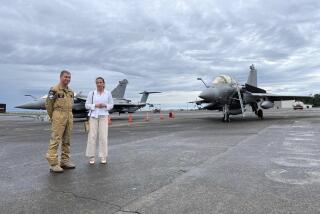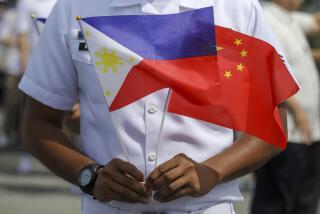U.S. Troop Role in Philippines at Issue
- Share via
WASHINGTON — Senior U.S. and Philippine defense officials are considering postponing a joint effort to track down Muslim separatist guerrillas in the southern Philippines because the two sides cannot agree on how to label the role of the American troops, Pentagon officials said Thursday.
The dispute -- which emerged after the U.S. announced last week that it was sending combat troops to the Philippines -- is embarrassing for both governments.
The Pentagon and Philippine defense officials are in broad agreement that about 3,000 U.S. troops will join Philippine soldiers to search the largely autonomous jungles of the southern island of Jolo in an effort to defeat an estimated 225 fighters from the Abu Sayyaf group, Pentagon officials said.
Defense officials on both sides of the joint effort had hoped to have the U.S. troops in the Philippines as soon as next month. But Philippine Defense Minister Gen. Angelo Reyes has said the effort might have to be postponed over details still to be worked out.
The differences, U.S. officials say, are almost entirely semantic.
“Ultimately, this does come down to the word ‘operation’ or ‘exercise,’ ” a U.S. defense official said.
Philippine officials want to call the effort a “training exercise,” U.S. officials said, because of internal political considerations and because their constitution restricts what foreign troops can do in the archipelago.
Pentagon officials, wary of opening a new, risky front in the U.S.-declared war on terrorism, say they have a responsibility to Congress and the public to call it what it is.
“The Pentagon does not want to call one thing another thing when it’s not,” the defense official said. “This is not an exercise. An exercise is a close thing under controlled circumstances. This is a military operation.”
Defense Secretary Donald H. Rumsfeld and Reyes are scheduled to meet today to iron out the terms of engagement for U.S. forces, but it appeared uncertain late Thursday that they would be able to bridge the differences, officials said.
U.S. defense officials also appear to be concerned about justifying sending troops to the Philippines as the war in Afghanistan continues and a possible war in Iraq looms.
“It’s another front in the global war,” said Dan Goure, a former Pentagon official who is now a defense analyst at the Lexington Institute, an Arlington, Va.-based public policy group. “You want to make sure these places don’t become chaotic and hence a breeding ground.”
The presence of U.S. soldiers is widely credited with driving the Abu Sayyaf from the island of Basilan last year. U.S. Army Special Forces soldiers provided counterinsurgency training to hundreds of Philippine troops at the battalion level for that operation but did not routinely join small companies of about 100 Philippine troops in their sweeps.
This time, about 350 U.S. special operations soldiers will join an estimated 300 who are already in the Philippines training rapid-response units and an additional 2,000 U.S. Navy sailors and Marines who would be patrolling the seas in an active effort aimed at capturing or destroying the remaining Abu Sayyaf members.
They would join 5,000 Philippine army soldiers in the Sulu region, mostly on the island of Jolo, a predominantly Muslim region of the Roman Catholic country.
In a meeting between Reyes and U.S. Adm. Thomas Fargo in Honolulu on Sunday, the military leaders had little difficulty agreeing that the Americans would plan for combat in support of the armed forces of the Philippines, defense officials said.
“Between the two militaries, there is no gap” in understanding the mission, a senior defense official said Thursday. “They knew exactly what we were going to say and how we were going to say it.... [Americans] will be on patrol with them, so they’ll have to be able to operate” in combat.
Nevertheless, Reyes told reporters that the joint effort might have to be postponed until the two sides could agree on terms.
The Pentagon had considered scheduling a joint news conference today with Rumsfeld and Reyes, where it would be difficult for the two sides to express differences from the same podium. But officials said Thursday that there would be no news conference, apparently because Reyes did not agree to appear. Reyes instead scheduled a news briefing at the office of his publicist.
Analysts say the two sides are likely to work out their differences eventually.
“There are some legal niceties that have to be massaged for public opinion inside the Philippines,” said Donald Emmerson, a professor and director of the Southeast Asia Forum at Stanford University.
Philippine officials hope to avoid any constitutional issues “by saying that although the Americans are in a combat role, they are support troops to the Filipinos -- assertions that may or may not match the realities on the ground.”
The joint effort is a particularly sensitive issue in the Sulu region, where the Abu Sayyaf has garnered widespread public support and where residents still tell tales of atrocities by U.S. soldiers early in the last century.
More to Read
Sign up for Essential California
The most important California stories and recommendations in your inbox every morning.
You may occasionally receive promotional content from the Los Angeles Times.













